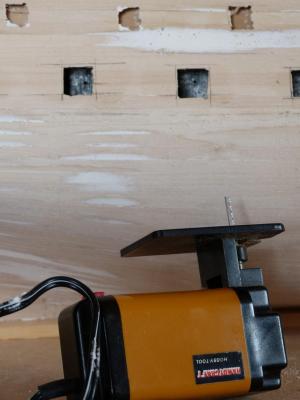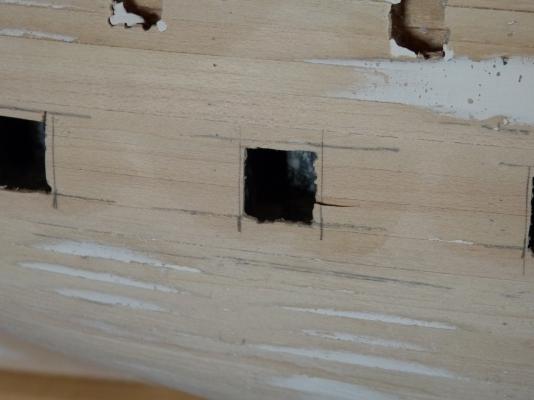-
Posts
199 -
Joined
-
Last visited
Content Type
Profiles
Forums
Gallery
Events
Posts posted by PMG
-
-
Still busy sizing the lowerdeck gunports. A very boring job with a needle file.
And my wife does'nt like at all the noise it makes. So I have to choose very carefully the time when I do it...
I am now looking for some piece of wood to make a 15x17 mm plug calliper.
Pierre
-
-
It's true. The Aeropiccola kit is a great one. High quality wood etc.
Apparently, mine must be an earlier version without double planking, but it does'nt matter.
If you except some "historical discrepancies" - but we can live with - it's a great model.
Some details about painting.
I already told that the "Nelson checker" painting scheme was more than probably not correct. However I followed it.
And it's more difficult than just following the curves of the wales.
At the time I did it, I think that the very good Admiralty paints of Caldercraft were not existing.
Finally, to be closer to the epoque colours I decided to use artist oil paints with true pigments as available in the time.
It gives a good result. Not always easy to apply (you have to dilute it a little bit, but not too much). The black is nice.
For the yellow, I used the pure yellow occre with a small addition of white. Finally, it appears a little bit too clear. It's a question of point of view.
The main problem with these paints is the time of drying. It's often better to wait 2 or 3 weeks to have it perfectly dry and pass the varnish.
Absolutely not recommended for Mobbsie!
Pierre
-
-
Thank you, Mobbsie, for your encouragement and good advises.
I already tought I was the slowiest monkey of the slow monkeys, but apparently not enough...
Pierre
-
Finally back in my "northern home" and to my Agamemnon.
I decided to continue the (fastidious) work of cutting precisely the gunports.
But I have been a little bit too conservative when drilling the holes, and so, there is still a lot of wood to remove with a file.
I found an old set of small tools I used for my Serapis, and rapidly putted the little saw you see on the picture in operation.
But it appeared not to be a good idea...
At certain places, after sanding, the first planking can be rather thin and often not supported by a frame. And, you can see on the next picture that I damaged the planking.
Repair is already done, but I think I will continue with a file...
Pierre
-
-
Very impressive start, Mobbsie.
And thank you for the very didactical pictures.
Pierre
-
Very nice job (as usual...).
You are very lucky to see Spitfires and Hurricanes flying above your head. And I understand that when you spend time to look to them you are not working at your Aggie...
Pierre
-
Hello Mobbsie,
Take care of you and come back as soon as possible fully operational!
Pierre
-
Hello Mobbsie,
When you take pictures, please, make some details of your gunports.
You know I am very interested by the question.....
Thanks
Pierre
-
OK Chris,
I understand now. It's the flag after capture by J. P. Jones.
I wondered about a british (and of course inexistant) flag. Thank you for the info.
Pierre
-
Thank you Rob for your nice photographies and clear and useful explanations.
For me you are really a reference in the building of the Agamemnon.
I am waiting the following steps.
Pierre
-
-
Hello Chris,
I was not aware about a Serapis flag. Can you give me more explanation?
Thank you.
Pierre
-
Fantastic progress, as usual, Mobbsie.
Greetings
Pierre
-
Thank you Martin,
But I am still online, and I have a good collection of pictures with me.
So, if we have to discuss a point, no problem, I need just to resize the picture.
Of course, there is no progress more to my build...
Pierre
-
I am now back in France for a couple of weeks, hoping the weather will finally be better.
But I have many things to do here, so I didn't take very much to do for my Agamemnon. If I have time, I shall try to make some oars for the boats, and eventually to continue carving the captain for my crew.
But, I continue to be on the forum.
Pierre
-
Let's now compare to the "french" version according to wikipedia.
24 x 24pdrs 58512 kgs
22 x 18pdrs 48068 kgs
6 x others (I assume 6pdrs) 5184 kgs
Total: 111.764 It's very much. Around 50% more than the original design value.
It's seems to me unlikely to have these heavy guns installed on a 5th rate.
They should eventually be carronades.
As a comparison we can considered the experimental armament installed on the "Rainbow" (also a 44, 5th rate, same class) in 1782.(in 1782, Serapis was already lost)
All carronades: 20 x 68 pdrs
20 x 42 pdrs
4 x 32 pdrs
A very impressive fire power (but not at long distance) weighing only 58500kgs. This seems more in line with sailing and fighting qualities.
I point also the fact that the Aeroppicola kit is supplied with a full set of british flags. I conclude that the designers of the kit were never intended to produce a "french" version of the ship, and I am not sure that precise records of such a version are existing.
We have so a broad choice of possible versions to build.... And a lot of fun!
My preferred (but it's too late for me to change) should be 20 x 18 pdrs + 22 x 12 pdrs + 2 x 6 pdrs + 10 x 32 pdrs carronades = in total 54 guns.
Pierre
-
Hello Steve,
I made a little bit of research and here is the result of.
I looked in Brian Lavery's book and also in a site called "histoire-de-fregates.com/chroniques.carronades" (this article is written in english).
Weights:
32 pdrs gun 56 cwt 2845 kgs
24 pdrs gun 48 cwt 2438 kgs
18 pdrs gun 43 cwt 2184 kgs
12 pdrs gun 30 cwt 1524 kgs
9 pdrs gun 24 cwt 1219 kgs
6 pdrs gun 17 cwt 864 kgs
18 pdrs carronade 10 cwt 508 kgs
32 pdrs carronade 17 cwt 864 kgs
42 pdrs carronade assumed 1200 kgs
68 pdrs carronade assumed 1500 kgs
If we look to the design armament of the HMS Serapis (class Roebuck), we have:
20 x 18 pdrs 43680 kgs
22 x 9 pdrs 26818 kgs
2 x 6 pdrs 1728 kgs
Total 72226 kgs
According to a new rule, it seems that during the construction time of Serapis the upper deck guns have been changed from 9 pdrs to 12 pdrs.
So, it becomes:
20 x 18 pdrs 43680 kgs
22 x 12 pdrs 33528 kgs
2 x 6 pdrs 1728 kgs
Total 78936 kgs
Then, in July 1779, a new regulation was issued, fitting the 5th rate ships (44 guns) with 10 carronades.
2 x 18 pdrs carronades on the forecastle: 1016 kgs
8 x 18 pdrs carronades on the quarterdeck: 4064 kgs
In total, we arrive to 84016 kgs and... 54 guns as mentionned in the litterature and as shown on the kit.
It's already a famous weight but it is still realistic.
It's probably in such a configuration that the battle with the Bonhomme Richard occured.
I have to stop now, I continue later in another post.
Pierre
-
Hello Steve,
I shall try to make the calculation of the weight of the guns in both cases.
Pierre
-
I agree with Chris. We have to consider the kit as generic.
But Steve is right too. May be that the kit designers tried to represent the Serapis under french flag. And, as she had been severely damaged, it is not improbable that she received major changes (such as a closed bulwalk) during refitting.
Under british flag I don't think that she received any changes. She was launched in March and lost in September.
On another way, the number and size of guns given by wikipedia for the french period seems to me very irrealistic.
One of the major problems of these 44 guns ships (class Roebuck) was that they were very low on the water, and, except in fair weather, it happened often that they could'nt even use their lower deck guns. With such an overweight like suggested by wikipedia I think that sailing and fighting qualities of the ship were very very poor.
Thank you for the interesting discussion.
Pierre
-
Hello Steve,
HMS Serapis is really an interesting ship.
There is a fact that there is not very much information available as the ship was lost in her first trip.
I know that she was experimental concerning the coppering. A large number of heavy guns on the quarterdeck seems to me unlikely, they must probably be carronades (relatively new at the time) and , may be, four 6pdrs..
Closed bulwalk and Nelson's checker seems very improbable too. When looking carefully to the drawings I got really the impression that the italian designer of the kit took most of his inspiration with the Victory of N. Longbridge.
OK for the davits, may be, but the absence of launch, pinnace or more significant boat than the two small supplied yawls seems strange to me.
If I could redo it, I surely should cut the closed quarter bulwalk and make an open version a little bit like what did Barbossa for his HMS Diana.
It should be interesting to have the possibility of having a look on the original drawings at the NMM, but I don't know how to do that.
Anyway, its a fine kit....
Pierre
-
I summarise, once for ever, the historical discrepancies I found in the Aeropiccola kit:
- closed quarterdeck bulwalk (not applied on that type of ship in 1779)
- Nelson checker as hull painting scheme. Appeared only around 1800.
- steering wheel located after the mizzen mast (should be in front of)
- boats on davits (appeared also only around 1800)
- ten 9pdrs guns on the quarterdeck. Surely too heavy. May be carronades, but less than 10. And missing 6 pdrs as chase guns on the forecastle.
- masting and rigging copying the N. Longbridge' Victory drawings. By example, the iron rings reinforcing the masts should be replaced by ropes. Iron was only used much later.
- missing galley and chimney.
- closed forecastle. It is unlikely that the there was a bulkhead in front of the galley.
- coppering. HMS Serapis was known to be the first ship of that size leaving the shipyard coppered.
However, the Serapis kit remains a nice piece, and if you are not too far in your build you can more or less easily correct the most obvious mistakes.
Despitely, I discovered most of them a little bit late and I have to live with an "hybrid" ship.
(by example, I already painted the Nelson's checker - not easy to do- and I am not intended to change)
Pierre







HMS Diana By Barbossa - Caldercraft - Scale 1:64 - The 1794 Attempt
in - Kit build logs for subjects built from 1751 - 1800
Posted
Hi Christian,
Your Diana is of an exceptionnal quality. The open bulwalk is beautiful.
I wish you a lot of success in the construction of your home. But,... protect your fingers!!!
Pierre